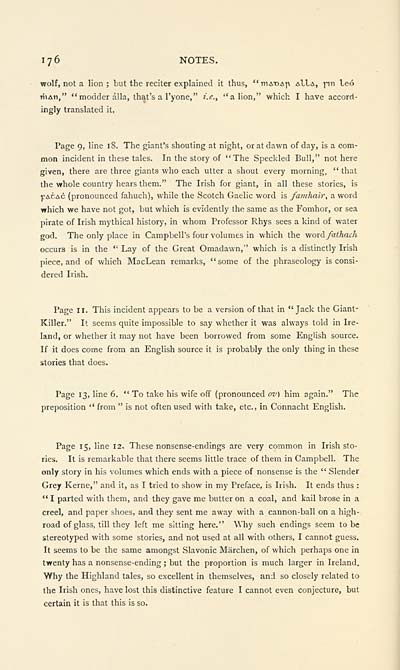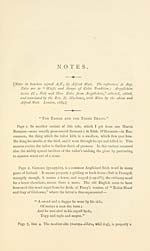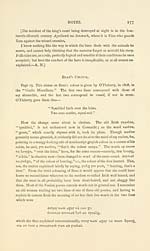Blair Collection > Beside the fire
(238)
Download files
Complete book:
Individual page:
Thumbnail gallery: Grid view | List view

176 NOTES.
wolf, not a lion; but the reciter explained it thus, "iha'daia aLIa, pii leó
liiAti," " modder alia, that's a Tyone," i.e., "alien," which I have accord-
ingly translated it.
Page 9, line 18. The giant's shouting at night, or at dawn of day, is a com-
mon incident in these tales. In the story of "The Speckled Bull," not here
given, there are three giants who each utter a shout every morning, " that
the whole country hears them." The Irish for giant, in all these stories, is
I^ACAc (pronounced fahuch), while the Scotch Gaelic word is famhair, a word
which we have not got, but which is evidently the same as the Fomhor, or sea
pirate of Irish mythical history, in whom Professor Rhys sees a kind of water
god. The only place in Campbell's four volumes in which the ■word/athach
occurs is in the " Lay of the Great Omadawn," which is a distinctly Irish
piece, and of which MacLean remarks, "some of the phraseology is consi-
dered Irish.
Page II. This incident appears to be a version of that in "Jack the Giant-
Killer." It seems quite impossible to say whether it was always told in Ire-
land, or whether it may not have been borrowed from some English source.
If it does come from an English source it is probably the only thing in these
stories that does.
Page 13, line 6. " To take his wife off (pronounced ov) him again." The
preposition " from " is not often used with take, etc., in Connacht English.
Page 15, line 12. These nonsense-endings are very common in Irish sto-
ries. It is remarkable that there seems little trace of them in Campbell. The
only story in his volumes which ends with a piece of nonsense is the " Slender
Grey Kerne," and it, as I tried to show in my Preface, is Irish. It ends thus :
" I parted with them, and they gave me butter on a coal, and kail brose in a
creel, and paper shoes, and they sent me away with a cannon-ball on a high-
road of glass, till they left me sitting here." Why such endings seem to be
stereotyped with some stories, and not used at all with others, I cannot guess.
It seems to be the same amongst Slavonic Miirchen, of which perhaps one in
twenty has a nonsense-ending ; but the proportion is much larger in Ireland.
Why the Highland tales, so excellent in themselves, and so closely related to
the Irish ones, have lost this distinctive feature I cannot even conjecture, but
certain it is that this is so.
wolf, not a lion; but the reciter explained it thus, "iha'daia aLIa, pii leó
liiAti," " modder alia, that's a Tyone," i.e., "alien," which I have accord-
ingly translated it.
Page 9, line 18. The giant's shouting at night, or at dawn of day, is a com-
mon incident in these tales. In the story of "The Speckled Bull," not here
given, there are three giants who each utter a shout every morning, " that
the whole country hears them." The Irish for giant, in all these stories, is
I^ACAc (pronounced fahuch), while the Scotch Gaelic word is famhair, a word
which we have not got, but which is evidently the same as the Fomhor, or sea
pirate of Irish mythical history, in whom Professor Rhys sees a kind of water
god. The only place in Campbell's four volumes in which the ■word/athach
occurs is in the " Lay of the Great Omadawn," which is a distinctly Irish
piece, and of which MacLean remarks, "some of the phraseology is consi-
dered Irish.
Page II. This incident appears to be a version of that in "Jack the Giant-
Killer." It seems quite impossible to say whether it was always told in Ire-
land, or whether it may not have been borrowed from some English source.
If it does come from an English source it is probably the only thing in these
stories that does.
Page 13, line 6. " To take his wife off (pronounced ov) him again." The
preposition " from " is not often used with take, etc., in Connacht English.
Page 15, line 12. These nonsense-endings are very common in Irish sto-
ries. It is remarkable that there seems little trace of them in Campbell. The
only story in his volumes which ends with a piece of nonsense is the " Slender
Grey Kerne," and it, as I tried to show in my Preface, is Irish. It ends thus :
" I parted with them, and they gave me butter on a coal, and kail brose in a
creel, and paper shoes, and they sent me away with a cannon-ball on a high-
road of glass, till they left me sitting here." Why such endings seem to be
stereotyped with some stories, and not used at all with others, I cannot guess.
It seems to be the same amongst Slavonic Miirchen, of which perhaps one in
twenty has a nonsense-ending ; but the proportion is much larger in Ireland.
Why the Highland tales, so excellent in themselves, and so closely related to
the Irish ones, have lost this distinctive feature I cannot even conjecture, but
certain it is that this is so.
Set display mode to: Large image | Transcription
Images and transcriptions on this page, including medium image downloads, may be used under the Creative Commons Attribution 4.0 International Licence unless otherwise stated. ![]()
| Early Gaelic Book Collections > Blair Collection > Beside the fire > (238) |
|---|
| Permanent URL | https://digital.nls.uk/76246313 |
|---|
| Description | A collection of Irish Gaelic folk stories. |
|---|---|
| Shelfmark | Blair.222 |
| Additional NLS resources: | |
| Attribution and copyright: |
|
| Description | A selection of books from a collection of more than 500 titles, mostly on religious and literary topics. Also includes some material dealing with other Celtic languages and societies. Collection created towards the end of the 19th century by Lady Evelyn Stewart Murray. |
|---|
| Description | Selected items from five 'Special and Named Printed Collections'. Includes books in Gaelic and other Celtic languages, works about the Gaels, their languages, literature, culture and history. |
|---|

